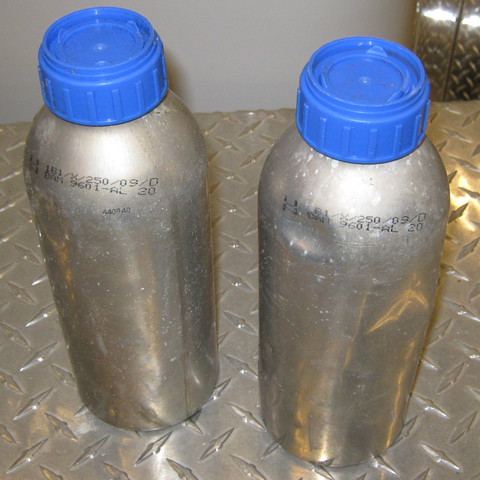Canisters along Ocean Shores
Ecology first learned of these unlabeled, silver metallic canisters on March 3, 2008. After retrieving a canister, Ecology tested the residue to confirm they once contained a poison used to kill pests in cargo holds of ships. Neither Ecology nor the Coast Guard have been able to determine the exact source of the canisters.
Summary information
Reports at Ocean Shores, Copalis Beach, and Ozette, WA

One liter aluminum canisters with blue plastic caps recovered from Sand Point and Ozette River areas.
Status updates
May 2011
The blue canisters shown on the right were recovered by Olympic National Park Ranger, Al Voner, on November 20, 2010, near Sand Point, and January 15, 2011, just north of the Ozette River. Canisters found in the past have had a red or green cap. These canisters with their blue caps appear to be from a new batch that had been recently discarded.
To date, 73 canisters have been recovered.
Some canisters still contained residual amounts of aluminum phosphide. When the chemical is exposed to air it becomes a toxic gas that poses a human health risk.
Advice for beachcombers or cleanup volunteers
If you find a canister:
- Containers with a lid - Canisters with lids could have some amount of the chemical inside. Without removing the lid, carefully collect the canister and store in a location away from the waterline. Report the location of the canisters to Ecology: 360-407-6300.
- Containers without a lid – Safe to pick up and recycle with other aluminum. The chemical reacts to oxygen and would have already dispersed when the lid was initially removed.
April 2010
As coastal communities gear up for beach cleanups on Saturday, April 17, the Washington Department of Ecology (Ecology) is reminding volunteers to keep an eye out for one-liter aluminum canisters that could still have potentially harmful contents inside.
So far this year, there have been no reports of these unmarked aluminum canisters being spotted along the Washington coastline.
November 2009
From spring 2008 through fall 2009, about 65 empty aluminum canisters were either spotted or picked up along the Washington coastline, causing concern among local residents. Some canisters still contained residual amounts of aluminum phosphide, a potent insecticide that becomes a toxic gas when exposed to air.
Information from the National Oceanic and Atmospheric Administration indicates the canisters likely came from cargo ships exporting bulk grain to Pacific Rim nations. These ships load grain at terminals on the Columbia River as well as Grays Harbor, Puget Sound and British Columbia.
The Washington departments of Agriculture and Ecology (Ecology) are working closely with fumigation companies, the grain export and shipping industry, shipping agents and port officials to keep these unwelcome 10-inch metal canisters off Washington beaches.
Some canisters still contained residual amounts of aluminum phosphide. When the chemical is exposed to air it becomes a toxic gas that poses a human health risk.
If anyone finds one of the canisters, Ecology’s spills and hazardous materials response team has the following advice:
- Don’t remove the plastic lid from the canister. It could still have some of the chemical inside.
- Without removing the lid, carefully collect the canister and store in a location away from the waterline.
- Immediately report the location of the canisters to Ecology at 360-407-6300.
April 2009
Ecology continues to receive reports of aluminum phosphide canisters. The latest discovery was of three canisters at Strawberry Point on the Olympic National Park wilderness beach (La Push area) on April 4.
Ecology believes the ones being reported now are the same type as the ones discovered in 2008.
In anticipation of the large volunteer-driven April 18 beach cleanup, Ecology wants to remind people how to safely handle these fumigant containers.
Source of canisters
Ecology first learned of the canisters from a beach cleanup volunteer in March 2008. Ecology staff began to collect and research the canisters to determine possible public health or environmental threat.
The containers found last year contained aluminum phosphide, a pest control used on cargo ships. When exposed to the air, the chemical becomes a toxic gas. When in contact with water, the phosphide becomes a more benign chemical compound similar to baking soda.
March 17, 2008
Ecology first learned of these unlabeled, silver metallic canisters on March 3rd. Since then, calls from the public have indicated that several hundred of these have been seen on beaches from just south of Tillamook, Oregon, to Vancouver Island, with most along the central and northern Washington Coast.
After retrieving a canister, Ecology tested the residue to confirm they once contained a poison used to kill pests in cargo holds of ships. Neither Ecology nor the Coast Guard have been able to determine the exact source of the canisters. The emptied containers likely were either washed away or thrown overboard from a cargo ship while traveling along the coast of Washington.
During the weekend of March 8-9, the Coast Guard assisted recovery efforts by scouring with trucks and ATVs all available coastline from Moclips to Long Beach, distributing flyers to citizens and park rangers from Neah Bay to Long Beach.
It is possible more canisters will continue to wash ashore.

